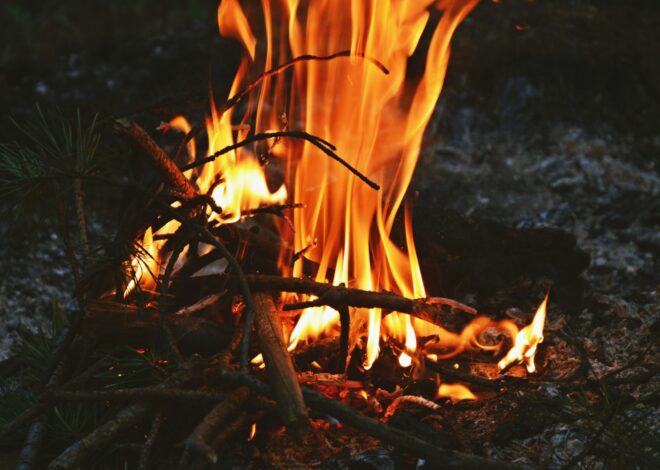
How To Learn Signaling For Survival
Welcome to our comprehensive guide on how to learn signaling for survival. Imagine finding yourself lost in the wilderness, far from civilization, with dwindling supplies and fading light. The odds of being rescued hinge on your ability to signal for help.
Learning how to effectively communicate your location can mean the difference between despair and survival. Signaling isn’t just about waving your arms or shouting; it’s an art that combines creativity, resourcefulness, and knowledge of techniques tailored for various situations.
In this guide, you’ll discover essential signaling strategies designed to catch attention when it matters most. From sound signals that pierce through silence to visual cues visible from miles away, mastering these skills ensures you are prepared for anything nature throws at you.
Whether you’re a seasoned adventurer or a casual hiker, knowing how to learn signaling for survival could save lives—perhaps even your own!
The Importance of Signaling in Survival Situations
Signaling plays a crucial role in survival situations. When you find yourself lost or injured, your ability to communicate your location can be the difference between life and death. In the wilderness, rescue teams rely on signals to locate individuals in distress.
Without effective signaling methods, one might remain undiscovered for hours or even days. The right signals increase visibility and urgency. Moreover, signaling is not just about being found; it’s also about conserving energy and resources. A well-timed signal can attract attention without exhausting oneself by wandering aimlessly.
Understanding how to convey messages clearly enhances your chances of survival dramatically. It fosters a sense of hope during dire circumstances—knowing that help could be just within reach if you signal correctly. Each moment spent mastering these skills prepares you for unpredictable scenarios ahead.
Mastering the Art of Signaling
Mastering the art of signaling can mean the difference between life and death in survival situations. It’s not just about making noise or waving your arms; it requires skill, knowledge, and a bit of creativity. Start by understanding your environment.
The landscape around you offers numerous opportunities for effective signaling. A high vantage point can amplify visual signals like flags or reflective materials. Practice various techniques until they feel second nature. Regular drills help reinforce these skills, ensuring you’re ready when it counts most.
Be aware of how weather conditions affect your signals too—rain or fog may obscure visibility but also create unique ways to be heard through echoes or distinct sounds. Utilizing landmarks effectively is another key component. They serve as reference points that increase the chances of being spotted from afar, allowing rescuers to pinpoint your location accurately.
Essential Tools for Signaling in Survival Scenarios
When it comes to survival signaling, having the right tools can make a significant difference. A whistle is an essential item; its sound carries far and requires minimal effort to use. Another invaluable tool is a mirror or reflective surface.
It allows you to catch sunlight and direct it toward rescuers from miles away. Even basic compact mirrors work wonders in this regard. Flares are excellent for nighttime emergencies, providing bright light that can be seen from great distances. They’re especially useful when visibility is low.
A simple flashlight with a strobe function can also serve as an effective signal at night or during inclement weather conditions. Brightly colored items like flags or even clothing stand out against natural backdrops, ensuring you’re more visible during daylight hours. These tools combined create multiple avenues for communicating your location in times of need.
Different Types of Signals and Their Purposes:
Signaling is crucial in survival situations, and understanding different types can make a significant difference. Each signal serves specific purposes based on the circumstances.
– Techniques for Creating Audible Signals
Creating audible signals can be a lifesaver in survival situations. The key is to make noises that carry over long distances. Whistles are one of the best tools for this purpose. Their high-pitched sound travels far and requires less effort than shouting.
If you don’t have a whistle, your voice can still work wonders. Shouting three short bursts can signal distress effectively. This pattern is universally recognized as an emergency call.
Another technique involves using natural objects around you. Clapping two sticks together or banging rocks creates noise that can attract attention.
It’s essential to practice these techniques regularly so they become second nature when needed most. Knowing how to generate loud sounds quickly could mean the difference between being found or remaining lost in the wilderness.
– Visual Signaling Methods
Visual signaling methods are essential in survival situations, as they can cut through noise and distance. They rely on the power of sight to convey messages.
One effective technique is creating large symbols or letters on the ground using rocks, branches, or even clothing. These visuals stand out against natural backgrounds and can be seen from afar.
Reflective materials like mirrors or aluminum foil can also be utilized. A quick flash directed towards potential rescuers captures attention quickly.
Flares offer another option for visual signaling during emergencies. They produce bright light and color that pierce through darkness and adverse weather conditions.
In addition, utilizing a whistle with a reflective surface helps combine both audible and visual signals effectively. Think creatively about your surroundings; nature itself offers many opportunities for innovative signaling techniques.
– Using Smoke and Fire for Signaling
Using smoke and fire for signaling is a time-tested method that can be incredibly effective in survival scenarios. The visibility of smoke over long distances makes it an ideal choice, especially in remote areas.
Creating a signal fire requires careful planning. Choose a location with good airflow to help the flames grow strong. Use dry wood as your primary fuel source, then add green leaves or wet grass to create thick, dark smoke that travelers or rescuers can easily spot.
Timing is crucial when using fire for signaling. Light your signal during daylight hours for maximum visibility but ensure it’s safe from wind changes or surrounding flammable materials.
Always have water nearby to control the fire if needed. Remember, safety first! A well-placed signal can mean the difference between being found quickly and waiting too long for help to arrive.
– Using Technology for Signaling in Emergencies
Technology has transformed how we approach signaling in emergencies. Devices like satellite phones and personal locator beacons (PLBs) can transmit your location to search and rescue teams, providing a lifeline when traditional methods fail.
Smartphones equipped with GPS capabilities are invaluable tools as well. They allow for quick messaging through apps designed for emergency situations, helping you communicate even when cellular networks are down.
Additionally, two-way radios offer effective communication over long distances without relying on external infrastructure. Many models come with features like weather alerts—essential for survival situations.
Always remember that technology requires power. Carry portable chargers or solar-powered options to keep your devices operational when you need them most. Integrating tech into your signaling strategy enhances safety but should complement traditional methods rather than replace them entirely.
The Importance of Practice and Preparedness
Practice and preparedness are vital components of effective signaling in survival situations. Knowing the theory is one thing, but applying that knowledge under pressure can be entirely different. Regular drills help embed these skills into muscle memory.
Whether it’s using a whistle or mirror to signal for help, consistent practice ensures you won’t hesitate when it truly matters. Preparedness also means having a plan. Think through various scenarios where you might need to signal for assistance. Visualize how you would respond and what tools you’d use in each situation.
Emotional readiness complements physical practice. Familiarizing yourself with potential stressors helps reduce panic if you’re ever lost or injured. The more prepared you feel, the better you’ll react when faced with uncertainty. Investing time in both practice and preparation equips you with confidence—an invaluable asset during emergencies.
Tips for Effective Signaling in Survival Situations
When you’re in a survival situation, clarity is key. Make sure your signals are easily recognizable from a distance. Use bright colors for visual signals; they stand out against natural backgrounds. Keep your signaling methods simple and consistent.
If you use sounds, like whistles or shouts, establish a pattern that others can recognize quickly. Timing matters too. Signal during the day when visibility is high and sounds travel further. At night, utilize light sources effectively to catch attention. Consider the environment around you.
Natural reflections can amplify sound or enhance visibility. Position yourself where rescuers are likely to be looking. Practice makes perfect—rehearse your signaling techniques regularly so they become second nature when it counts most. Remember to remain calm; panic can cloud judgment and hinder effective communication with potential rescuers.
Common Mistakes to Avoid When Signaling for Help
When signaling for help, clarity is crucial. One common mistake is using signals that are too subtle or complex. Keep your messages simple and straightforward to increase their chances of being understood. Another error people make is failing to consider the environment.
Sound can travel differently in various landscapes, while visual signals might be obscured by trees or terrain. Always assess your surroundings before choosing a signaling method. Also, many forget about timing. Signaling during poor visibility conditions—like fog or heavy rain—can render efforts ineffective. Choose moments when you’re more likely to be seen or heard.
Neglecting practice leads to confusion under pressure. Regularly rehearse your signaling techniques so they become second nature when it counts most. Each detail matters when seeking rescue; do not overlook even the smallest aspect of your strategy.
Other Survival Techniques to Utilize Along with Signaling
Signaling for help is crucial, but survival extends beyond just making noise or creating visual cues. Knowing how to build a shelter can provide protection from harsh weather and keep you warm. Finding clean water is another essential skill. Without it, your chances of survival diminish quickly.
Techniques like digging near streams or collecting rainwater can be lifesaving. Food procurement should also be part of your strategy. Learn basic foraging skills and recognize edible plants in your area. This knowledge could sustain you during an extended emergency.
Navigation skills are equally important. Use natural landmarks or simple tools to find direction if you’re lost. First aid knowledge equips you with the ability to handle injuries that may arise during a crisis situation. Each skill complements signaling efforts, enhancing overall preparedness in any environment.
Conclusion: Be Prepared for Any Situation with Signaling Skills
Being prepared for any situation means equipping yourself with a versatile set of skills, and signaling is a crucial part of that toolkit. Mastering the art of signaling can make all the difference in survival scenarios. It’s not just about having the right tools; it’s also about knowing how to use them effectively. Practice is essential.
Regularly rehearsing your signaling techniques will help you react instinctively when faced with emergencies. Understanding different types of signals—audible, visual, smoke, or technology-based—ensures you are ready for various situations. Remember that common mistakes often stem from panic or lack of preparation.
By familiarizing yourself with effective strategies and avoiding these pitfalls, you’ll enhance your chances of being rescued. Survival isn’t solely about enduring harsh conditions; it’s about creating opportunities for rescue and assistance when needed most. With proper knowledge and practice in signaling methods, you’re taking significant steps toward ensuring your safety—and possibly saving lives along the way.



